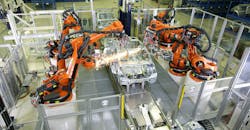Manufacturers aren’t entirely familiar with the opportunities and benefits the Internet of Things (IoT) can deliver. In fact, 30% of manufacturers struggle to understand the IoT altogether, according to a study by advisory firm Sikich. But that lack of insight hasn’t stopped them from making the IoT a point of emphasis moving forward.
According to the 2018 Leading Edge Alliance (LEA) National Manufacturing Outlook, half of all manufacturers plan to prioritize IoT technologies, including connected machinery, software, systems and sensors, in the coming years.
To successfully implement IoT technologies and make the most of their time and money, here are answers to some common questions manufacturers typically have as they begin their journey.
How can I cut down on maintenance costs?
Decreased production along with high repair costs can make it difficult – if not impossible –to achieve goals in the event of a breakdown. However, IoT insights can reduce such pain points.
Instead of waiting to repair a piece of equipment until it breaks down, manufacturers can leverage IoT data to identify potential issues long before they turn up. If, for example, a machine is constantly overheating, maintenance may be needed sooner than originally expected. Manufacturers who consider such information can reduce downtime while also avoiding more serious – and consequently more expensive – repairs.
Research from McKinsey estimates that data-powered predictive maintenance not only extends equipment longevity, but also minimizes downtime by as much as 50%.
What will it take to improve decision-making and efficiency?
Data drives decision-making — or at least it should. For far too long, manufacturers balanced production processes with little insight into actual activity on the factory floor. The result? Inefficient operations and missed opportunities.
Those missteps are taking a turn for the better. Manufacturers who leverage IoT technology with an eye on planning also are poised to increase their efficiency. Rather than assuming production is going as planned, manufacturers can use connected equipment to get a picture of what’s happening in real time. This immediate access to machine data can help manufacturers reallocate manpower and resources as needed.
In the same way connected equipment sets the stage for increased efficiency, automation tools like robotics can help provide the insight needed to optimize production processes. Sensor-enabled robots stand to collect information about themselves as well as the surrounding environment, ensuring any abnormalities or opportunities for process improvement are communicated to manufacturers via the IoT.
Increased connectivity ushered in by the IoT also opens the door for seamless tracking of tools and other crucial parts of the manufacturing process. Time spent searching the factory floor or browsing through extensive inventory lists can be dedicated to more pressing issues such as improving product quality or boosting efficiency.
How can I encourage synergies across teams?
Manufacturers hoping to maximize the impact of the IoT must align internal information technology (IT) and operational technology (OT) experts. But if history is any indication, that’s often easier said than done. Less than half of all manufacturers report that their IT and OT teams have worked together to tackle issues like legacy operations system upgrades.
One way around this lack of collaboration is by developing a new team of both IT and OT workers. With the common goal of delivering value to the organization, such a group is much more likely to work together to leverage their talents and knowledge. For example, OT teams usually have plenty of operational data that’s poised to enhance real-time decision-making. Instead of letting this information go to waste, OT can collaborate with analytics-savvy IT workers to identify new use cases.
While most manufacturers are onboard with taking a closer look at IoT technologies, there’s still some mystery around the potential benefits. Prior to implementation, manufacturers should reflect upon a few areas where the IoT can make its greatest impact. From improving decision-making to increasing efficiency, pinpointing the IoT’s value proposition can clear up confusion and open doors to a future of connectivity.
Andy Chang is the director of product marketing, Americas, at Kuka.
About the Author
Andy Chang
Director of Product Marketing, Americas
As director of product at Kuka, Chang focuses on introducing new cloud, web and mobile technologies that augment traditional robotics operating technologies, including simulation, configuration, programming and lifecycle management. He also leads portfolio management for all IoT and Industry 4.0 products. Leveraging a platform-based approach, Chang has helped create holistic workflow solutions that set the industry standard for capability and ease-of-use in product lifecycle management.
Before joining KUKA in September 2015, Chang held various professional positions ranging from a controls engineer to a global program manager for academic research responsible for driving strategic partnership, product management, product strategy and field enablement.
Chang has written more than 100 scientific articles and publications. Chang graduated from the University of Michigan with a master’s degree in mechanical engineering and received his bachelor’s degree in mechanical engineering from the University of California, San Diego.
